The report mentions information, opinions, and judgments about the market, projects, currencies, etc., for reference only and does not constitute any investment advice.
Macro Market
In July, the market hesitated, and it was fully vented in August.
The hawkish stance of the Federal Reserve, the tightening of monetary policy in a high-interest rate environment, and concerns about corporate recession have made participants in various markets more cautious.
Although the monthly decline was only 2%, the Nasdaq, which had previously risen for five consecutive months, had a maximum decline of over 8% in August. Whether the Nasdaq will start a downtrend thereafter is still unknown, and the hesitation has cast an uncertain veil over global financial markets.
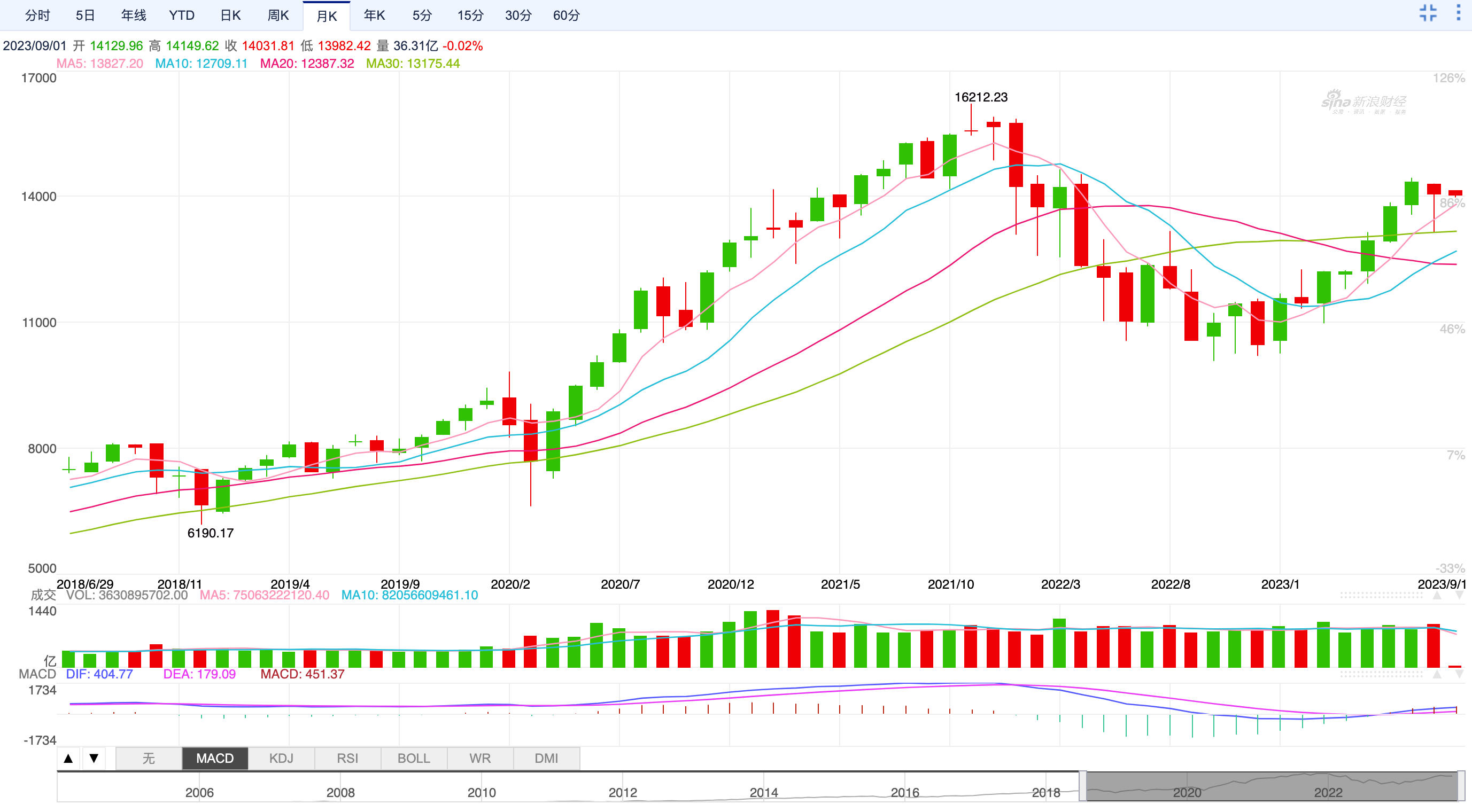
Monthly trend of Nasdaq
Meanwhile, the situation in the cryptocurrency market in August was even more severe.
The balance line at 29000 was completely lost, and both sides of the market reestablished a balance line at 26000 US dollars.
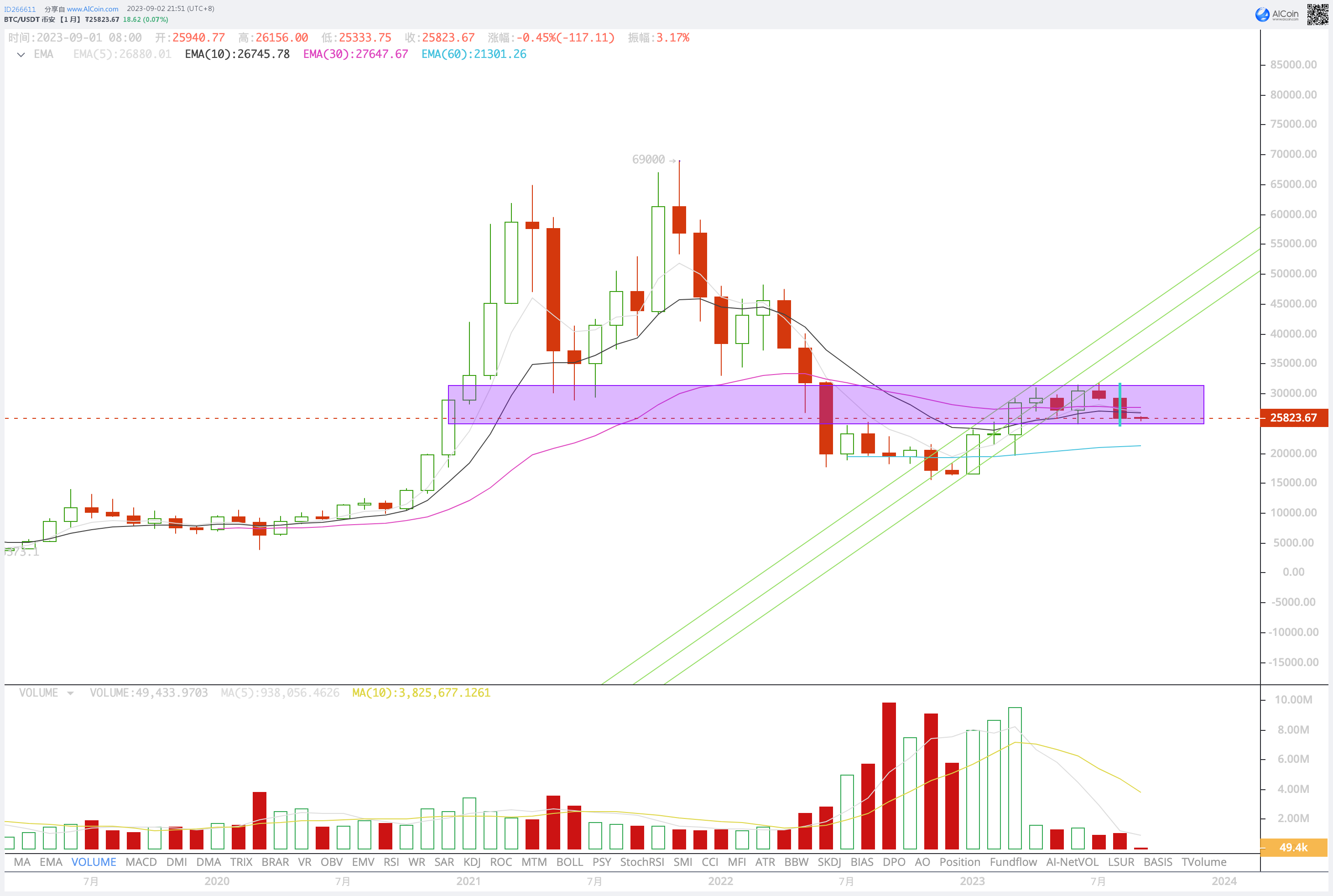
Monthly trend of BTC
In August, the "pump and dump" trend reappeared, indicating that the market has lost trend certainty and volatility has dropped to the third-lowest in history, with pricing power being driven by rumors and emotions.
The on-chain data shows that the divergence between long and short positions continues to widen. Long positions are still absorbing liquidity, but 88% of short positions are in a loss state, continuously selling off under various news stimuli. On the one hand, they are pricing the market downward, and on the other hand, they continue to drive the major task of clearing liquidity in the recovery period.
Cryptocurrency Market Trend
In August, BTC opened at $29,232 and closed at $25,655, exceeding the price drop expectation of $28,000 set by EMC Labs in their July brief, once again approaching the June low point. It recorded a monthly decline of 11.26%, marking the largest daily and monthly decline since the rebound from the beginning of the year. As the sharp drop occurred, the trading volume also slightly increased.
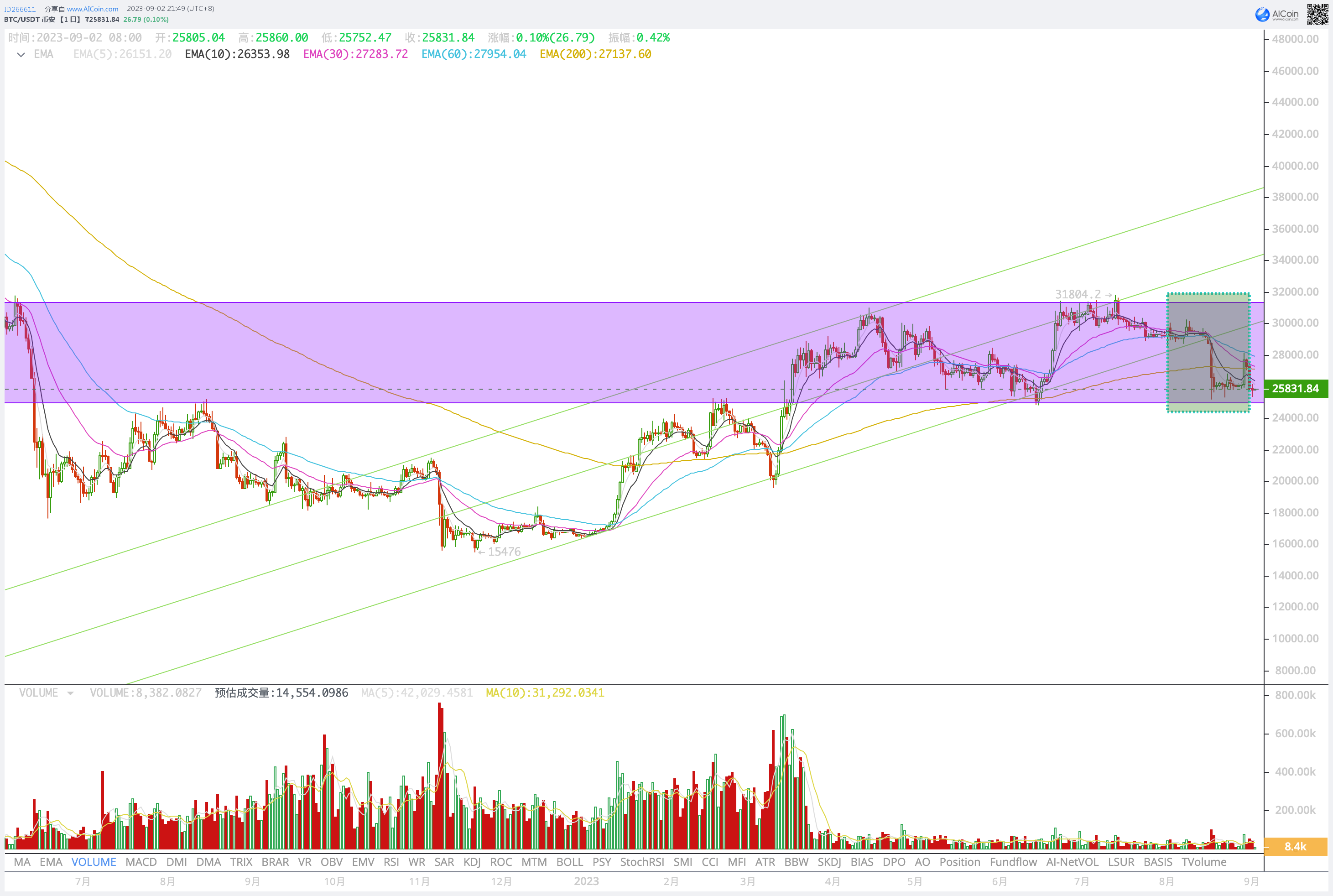
BTC Daily Trend
The lower bound of the ascending channel was broken on August 16, and the subsequent sharp drop of 7% was triggered by rumors of Space X selling BTC. This sharp drop not only indicates the complete end of the upward trend (the third wave of the recovery period rebound) since the beginning of the year but also completely clears the market effect brought by the application of the BlackRock BTC spot ETF.
The scarcity of new funds has caused rumors and emotions to become the dominant factors in the market. So, has the core agenda of the recovery period been affected?
Long vs. Short Game
We once again turn our attention to the size of long and short positions to judge the effectiveness of the market cycle stage.

Position size of various parties in the market
In August, the long position increased from 14.56 million coins at the end of July to 14.71 million coins, a net increase of 150,000 coins.
The short position decreased from 2.61 million coins at the end of July to 2.52 million coins, a net decrease of 90,000 coins.
The exchange balance decreased by 30,000 coins, with a balance of 2.26 million coins.
In July, the increase in the long position was 96,000 coins, much lower than the 150,000 coins this month. This means that as the BTC price sharply fell, the long position camp became more determined in increasing their holdings instead of decreasing.
On the other hand, the decrease in weak hands increased from 20,000 coins in July to 90,000 coins, indicating that price fluctuations remain the main driving factor for weak hands trading, and the rate of fluctuations determines the scale of their increase or decrease. The outflow from exchanges in August decreased by 10,000 coins compared to July, indicating that the increase in the long position mainly came from the decrease in the short position.
From the comprehensive data, it can be seen that the market is still operating well in the recovery phase, with the long position continuing to increase and the short position continuing to decrease. The market liquidity is continuously being absorbed, which means that the on-chain data still supports the upward trend of BTC price in the medium to long term.
Supply Trend
As of the end of August, the overall market's floating profit situation has deteriorated significantly, dropping from 43% to 28%. The floating profit of the long position decreased from 44% to 27%, while the short position went from a floating profit of 3% to a floating loss of 8%.
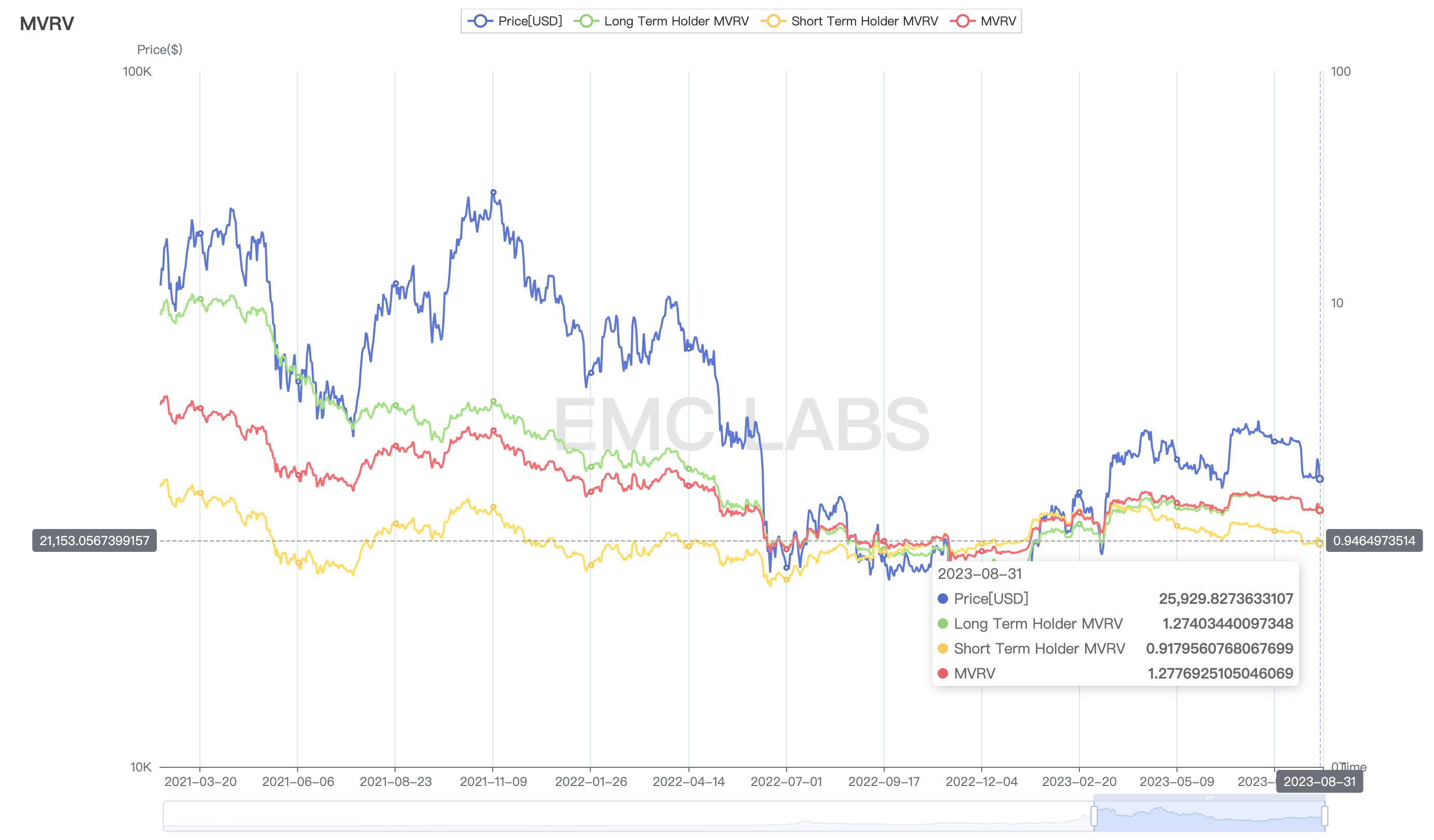
Market Supply Pressure
We further analyze the selling insights and examine the profit and loss situation when selling BTC in both long and short positions.
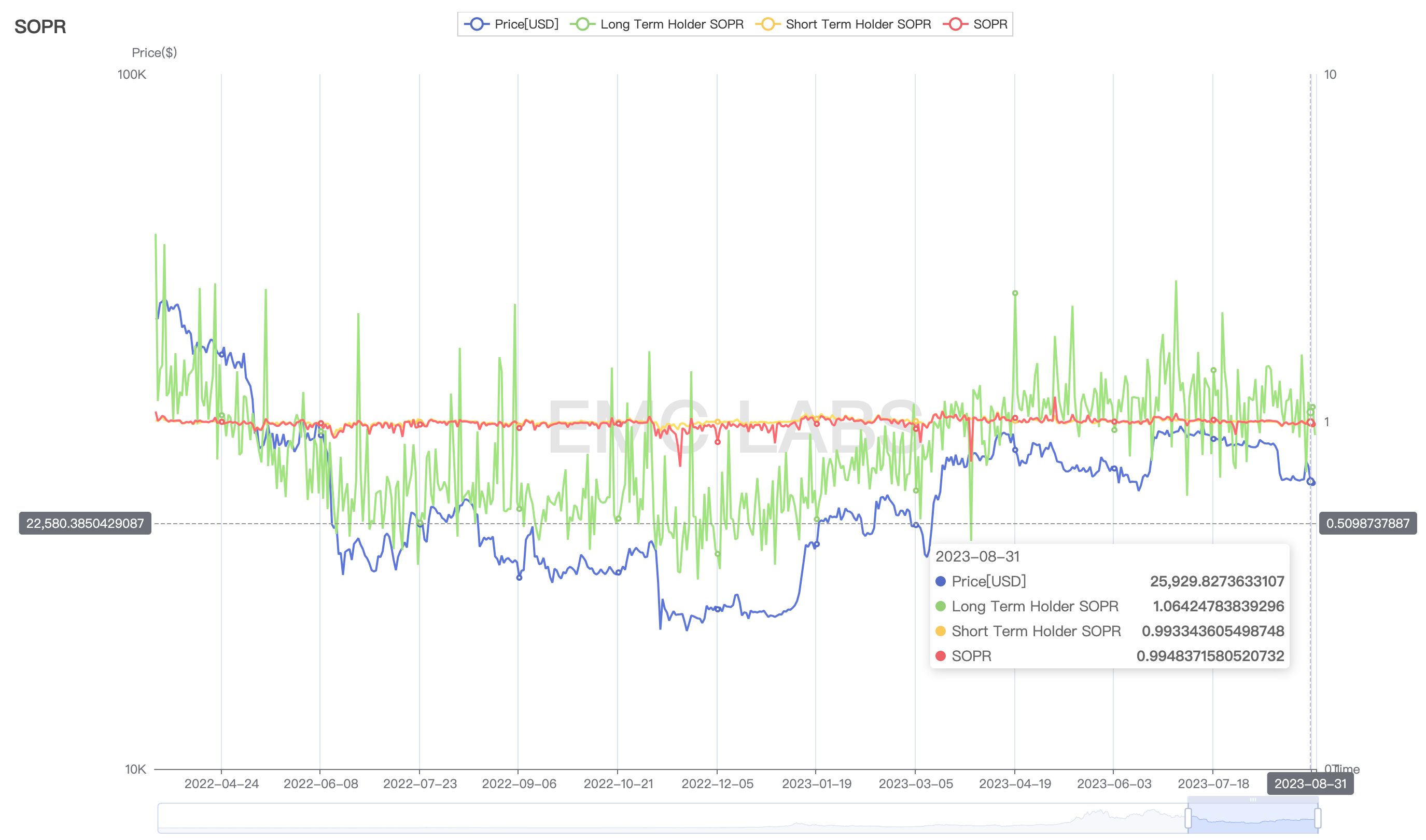
BTC Selling Profit and Loss
The market downturn and panic triggered a significant price decline, and the selling of BTC is both the cause and the result of the decline.
The highest daily profit for long positions is 56%, and the lowest is -29%, maintaining a profitable status throughout the month, although the profit margin has decreased compared to July.
The highest daily profit for short positions is 0.5%, and the lowest is -3%, maintaining a loss status throughout the month.
The ratio of selling volume between long and short positions is maintained at 1:10, with short positions controlling the pricing power due to their absolute scale advantage.
The "supply faucet" has slightly converged but remains open. The overall supply and profit/loss status of the market is still within the repair period trend.
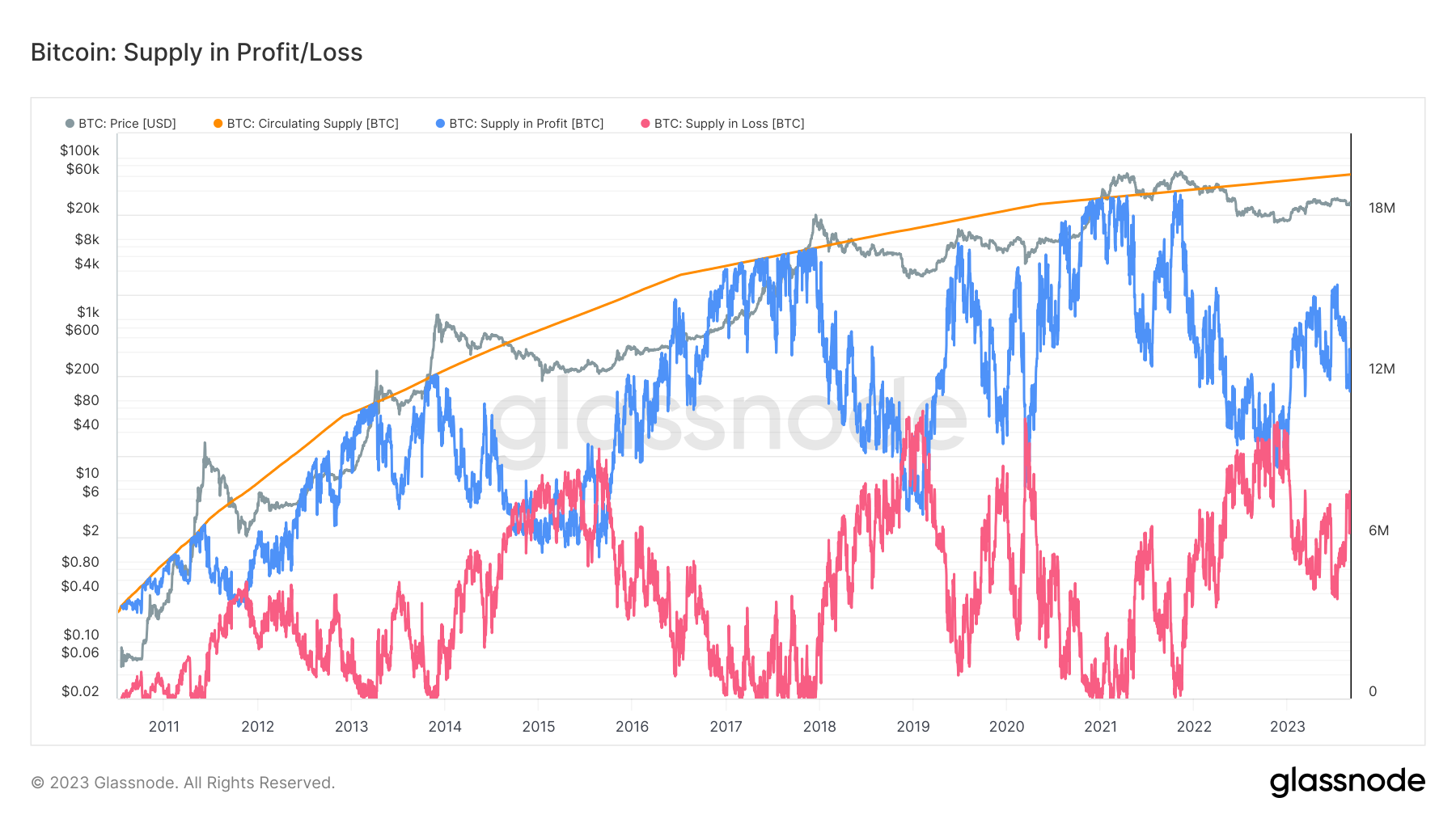
Overall Market BTC Profit and Loss
Whale Selling
In the July briefing, we analyzed that, apart from the long and short perspective, in terms of the scale of holdings, the whale group (entities holding more than 1000 coins) dominated the adjustment in July. In August, this trend continued, and the whale group continued to sell significantly, although the scale was reduced compared to July.
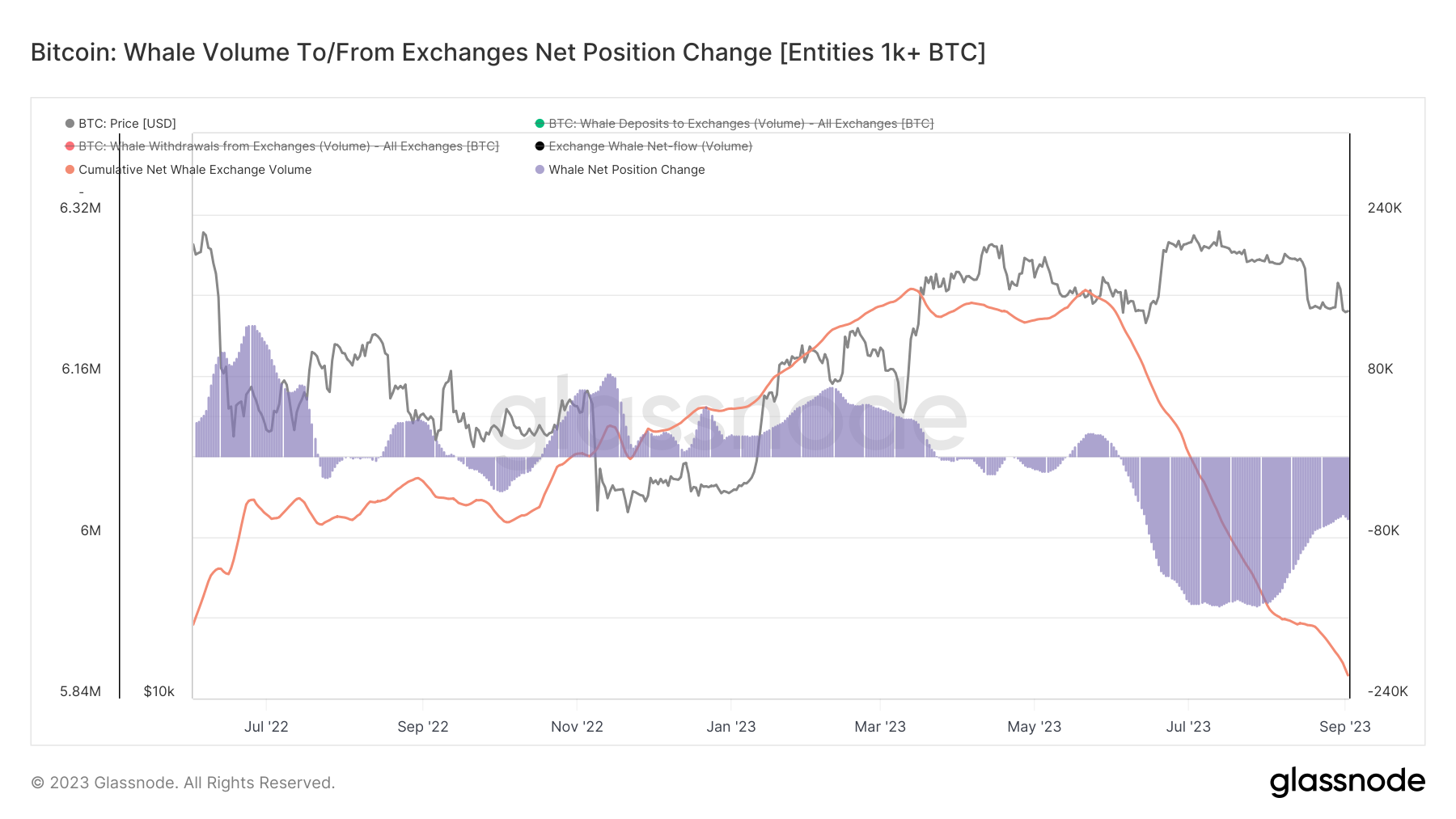
Whale inflow/outflow scale
The sell-off by short-term whales continues and remains around 50,000 coins per day until the end of the month. Although it has declined significantly from the peak of 140,000 in July, considering the daily net inflow of exchanges at around 30,000, this sell-off still has a decisive impact on price trends.
In the long term, the total holdings of the whale group reached a historical high of 6,237,357 coins on May 26 and continued to decrease to 5,875,150 coins by the end of August, with a total reduction of 360,000 coins.
EMC Labs believes that the market pressure during this period mainly comes from the large-scale selling by short-term whale groups. Although this selling trend has weakened, it has not stopped.
On-chain activities
Let's turn to the support foundation of the long-term market - on-chain activities.
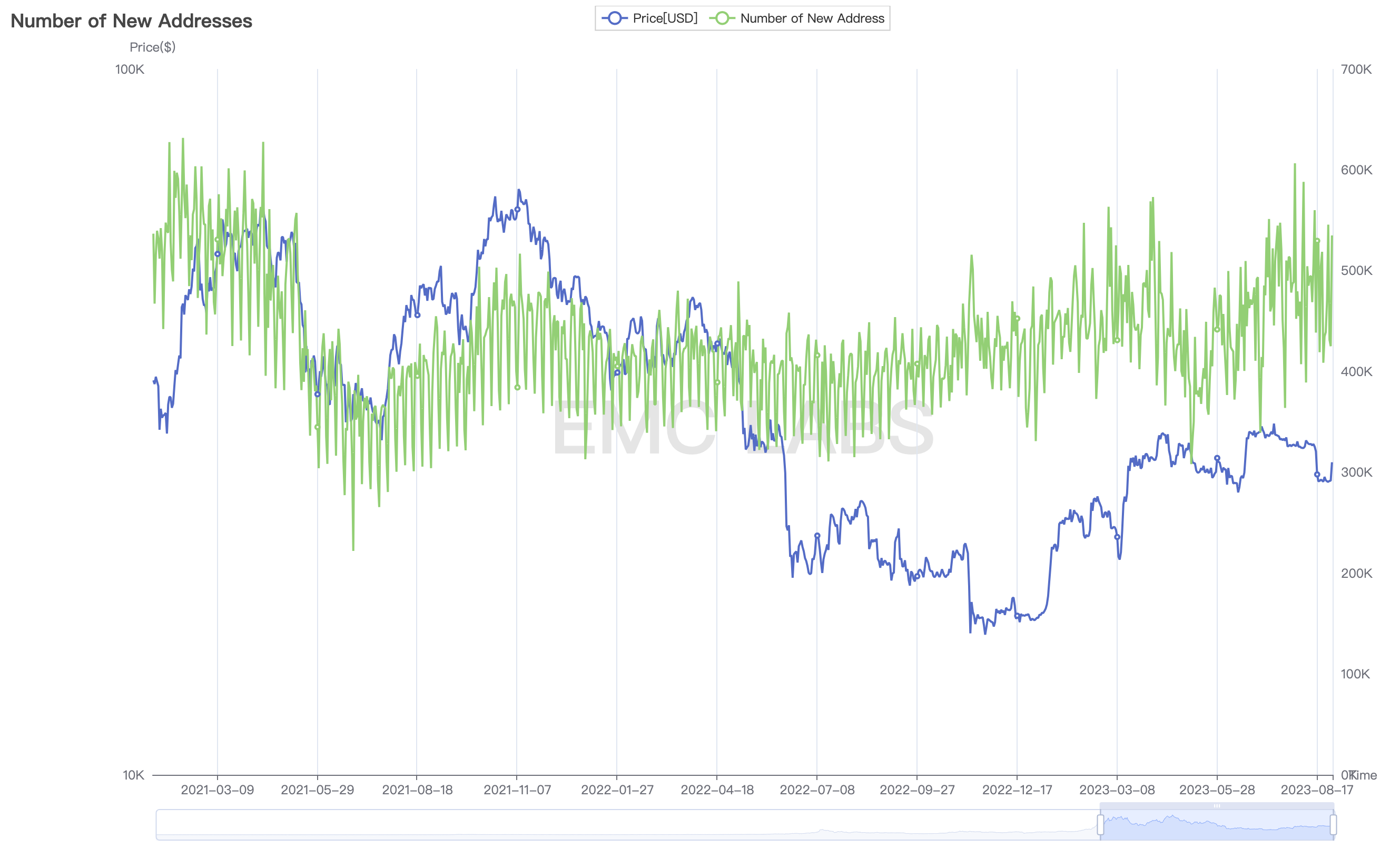
BTC daily new address volume
Compared to July, there has been a slight decrease in the number of new addresses, especially during the flash crash period. However, the overall trend still remains within the medium-term upward channel, and the number of new addresses on weekends has been steadily increasing. The continuous expansion of new addresses demonstrates the gradual accumulation of growth momentum during the recovery period.
In terms of active addresses, Mempool Transactions saw a significant decline in early August, followed by a gradual recovery and reaching the highest point since January during the rebound in the week of August 29th. Considering the frenzy of Ordinals minting in the previous May, the occurrence of this high point is very encouraging.
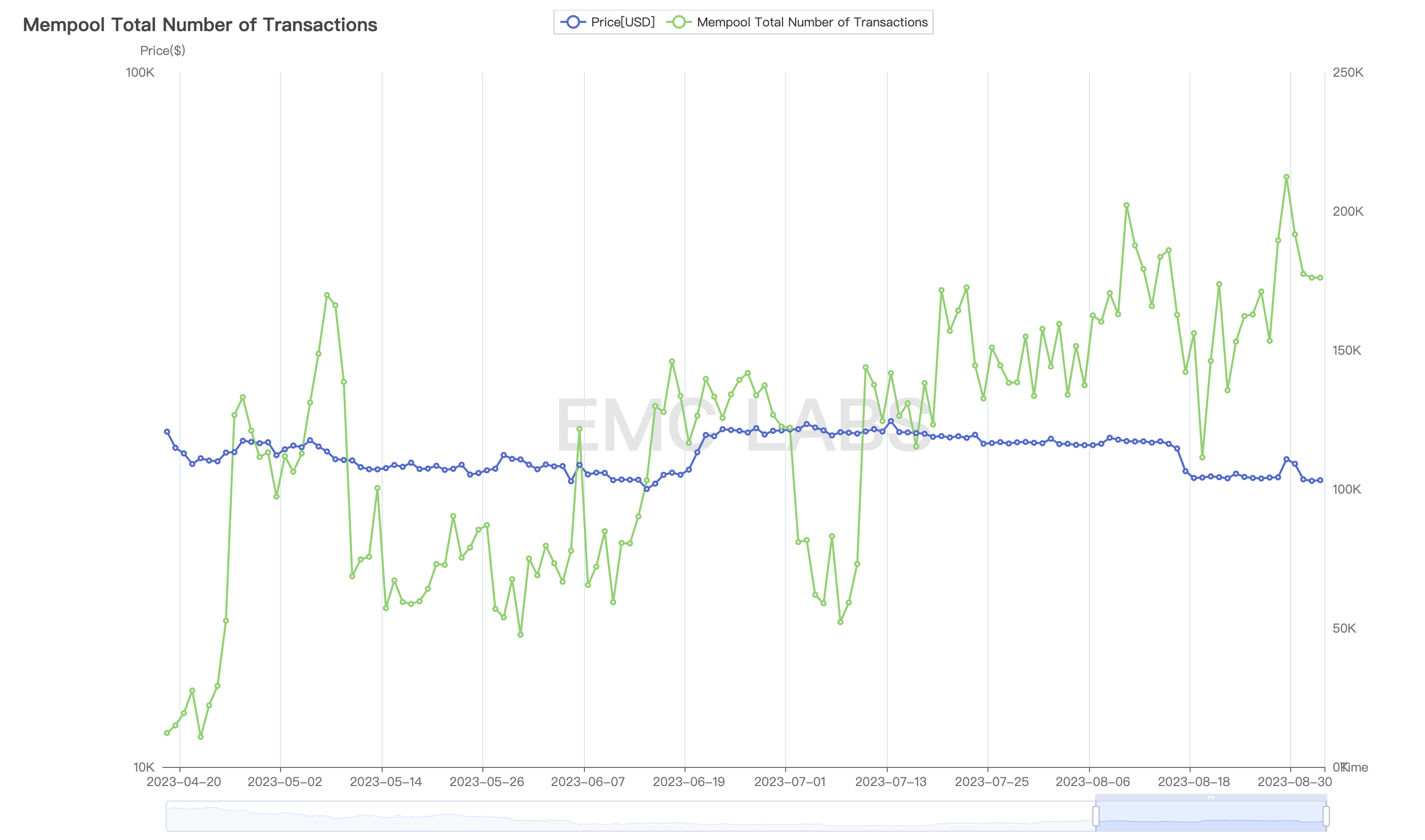
Mempool Transactions daily queue size
Incremental Funding
Incremental funding remains pessimistic. The outflow of funds since the major sell-off continues, with stablecoin net outflows reaching $1.4 billion in August, on par with July. We believe the reason for this ongoing outflow of funds needs to be sought externally, namely in the macro financial market.
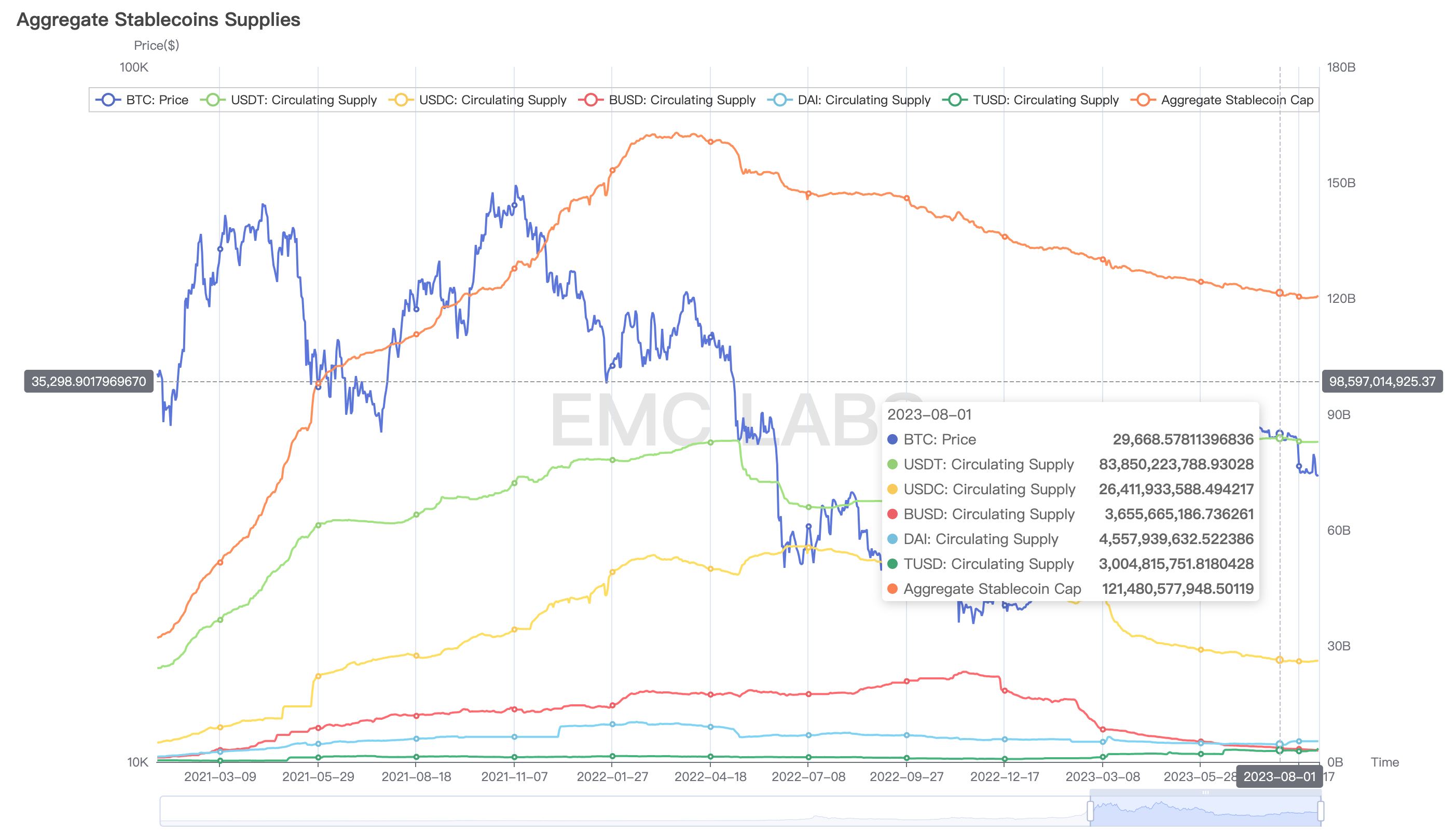
Major stablecoin supply
Relatively optimistic data can be seen in the CEX stablecoin inventory, as the overall outflow situation in August has greatly improved and even experienced net inflows in a short period of time. This indicates that the overall selling willingness in the market is very low at the $26,000 level.
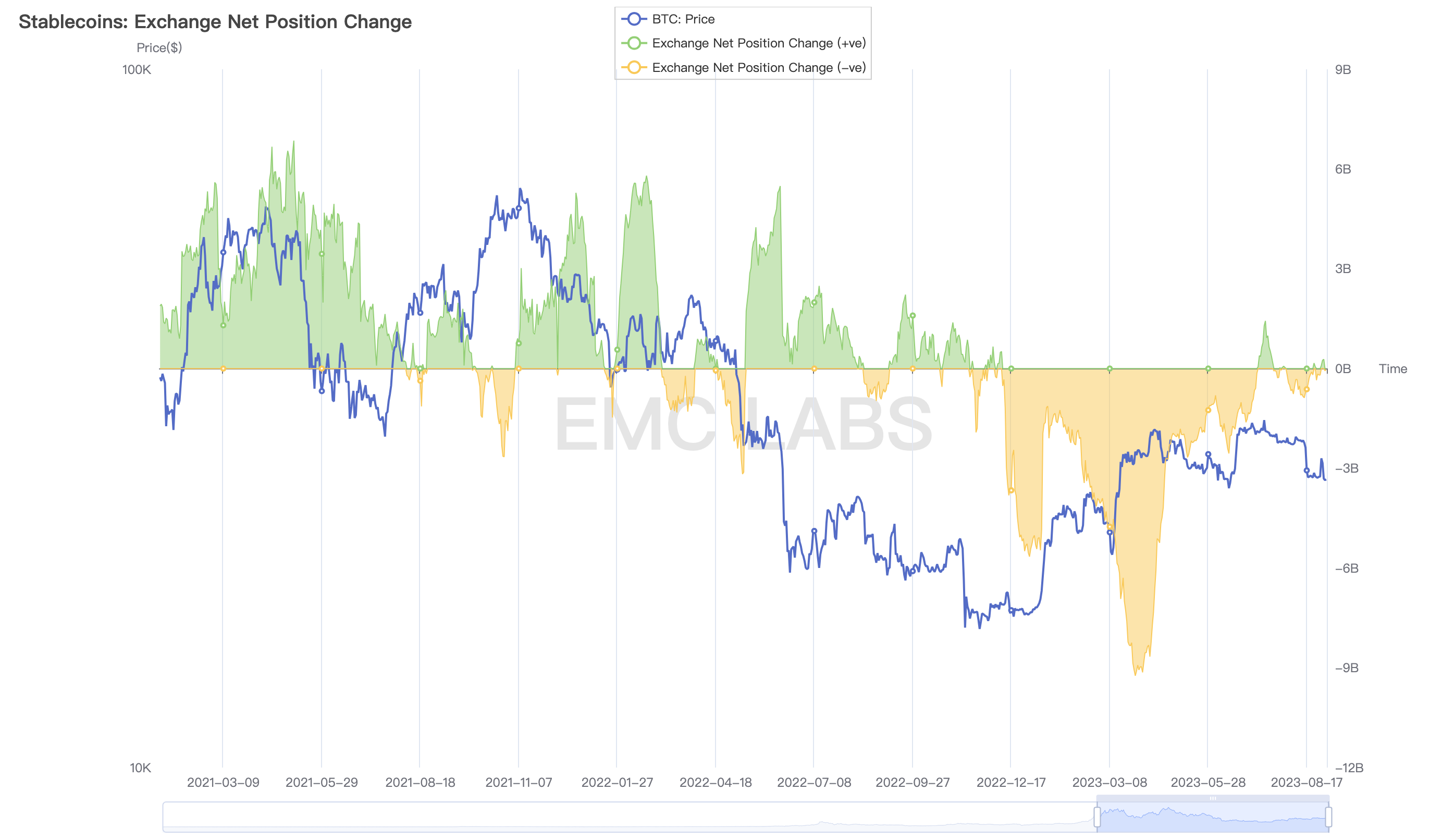
Net inflow/outflow of stablecoins on centralized exchanges
Conclusion
In August, the market was as dull as in July. Funding was overall in an outflow state, with a total outflow of 1.4 billion US dollars from the market, and various parties in the market adjusted their positions amid new pressures. Long-term investors continued to accumulate chips, while short-term investors, especially short-term whales, continued to sell, but the selling volume has been decreasing. The overall supply is still within the repair period indicator, indicating that long-term investors still have control over the long-term market trend.
What is worth noting is the repair and growth of on-chain data, with new addresses continuing to increase, and Mempool Transactions data even reaching a new high since the rebound in January.
In the July report, EMC Labs pointed out that "the biggest risk should be whether the macro financial market can withstand the high interest rate environment of the US dollar." The market performance in August just confirms this point. The Federal Reserve's tone remains tough, the Nasdaq ends its 5-day rally, and BTC is seeking support around $26,000 after a sharp decline.
After breaking away from the support of the rising trend, BTC has fallen to the lower border of the $25,000 ~ $31,000 box, and further down, it will test $20,000, which is the bottom of the previous bull market.
EMC Labs believes that this kind of decline during the repair period is a very low probability event. If it happens, the driving force will still come from the macro financial market, such as another interest rate hike, financial market collapse, and economic recession.
The active state of on-chain data indicates that there is still a possibility, and the probability is not low, for BTC to experience a rapid and significant rebound in the medium to short term.
EMC Labs (Emerging Labs) was founded by cryptocurrency investors and data mining engineers in April 2023. It focuses on research in the blockchain industry and investment in the Crypto secondary market. With industry foresight, insights, and data mining as its core competitiveness, EMC Labs is committed to participating in the booming blockchain industry through research and investment, and promoting blockchain and cryptocurrency assets for the benefit of humanity.
For more information, please visit: https://www.emc.fund



